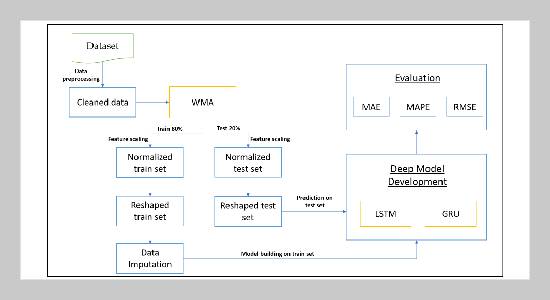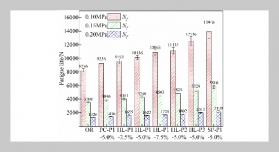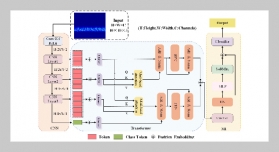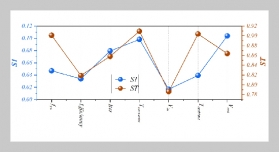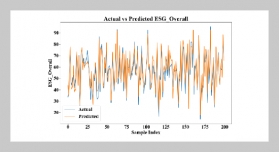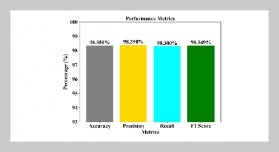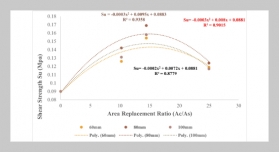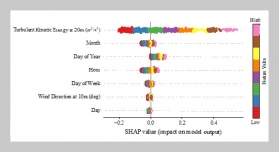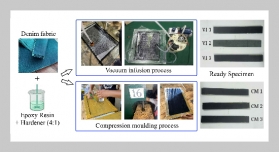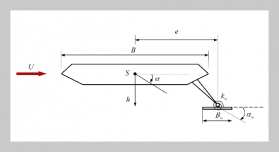- [1] OECD. Data and Metadata Reporting and Presentation Handbook. Paris, France: OECD Publishing, 2007, 61.
- [2] S. Hansun, V. Charles, C. R. Indrati, and Subanar, (2019) “Revisiting the Holt-Winters’ Additive Method for Better Forecasting" International Journal of Enterprise Information Systems 15(2): 43–57. DOI: 10.4018/IJEIS.2019040103.
- [3] Y. Uygun, M. O. Erboy, M. S. Aktas, O. Kalipsiz, and I. Aykurt. “Technical Analysis on Financial Time Series Data Based on Map-Reduce Programming Model: A Case Study”. In: 2018 International Congress on Big Data, Deep Learning and Fighting Cyber Terrorism (IBIGDELFT). Ankara, Turkey: IEEE, 2018, 92–97. DOI: 10.1109/IBIGDELFT.2018.8625357.
- [4] V. M. Kureychick and T. G. Kaplunov, (2019) “Time series forecasting method based on genetic algorithm for predicting the conditions of technical systems" Journal of Physics: Conference Series 1333(3): 032046. DOI: 10.1088/1742-6596/1333/3/032046.
- [5] S. Makridakis, E. Spiliotis, and V. Assimakopoulos, (2020) “The M4 Competition: 100,000 time series and 61 forecasting methods" International Journal of Forecasting 36(1): 54–74. DOI: 10.1016/j.ijforecast.2019.04.014.
- [6] S. Hansun and S. Subanar, (2016) “H-WEMA: A New Approach of Double Exponential Smoothing Method" TELKOMNIKA (Telecommunication Computing Electronics and Control) 14(2): 772. DOI: 10.12928/telkomnika.v14i2.3096.
- [7] S. Hansun. “A new approach of moving average method in time series analysis”. In: 2013 Conference on New Media Studies (CoNMedia). IEEE, 2013, 1–4. DOI: 10.1109/CoNMedia.2013.6708545.
- [8] G. Zhang, (2003) “Time series forecasting using a hybrid ARIMA and neural network model" Neurocomputing 50: 159–175. DOI: 10.1016/S0925-2312(01)00702-0.
- [9] R. H. Shumway and D. S. Stoffer. “ARIMA Models”. In: Time Series Analysis and Its Applications. Springer, Cham, 2017, 75–163. DOI: 10.1007/978-3-319-52452- 8_3.
- [10] B. Lim and S. Zohren, (2021) “Time-series forecasting with deep learning: a survey" Philosophical Transactions of the Royal Society A: Mathematical, Physical and Engineering Sciences 379(2194): 20200209. DOI: 10.1098/rsta.2020.0209.
- [11] S. Hansun and J. C. Young, (2021) “Predicting LQ45 Financial Sector Indices using RNN-LSTM" Journal of Big Data 8(1): 104. DOI: 10.1186/s40537-021-00495-x.
- [12] D. Yi, S. Bu, and I. Kim, (2019) “An Enhanced Algorithm of RNN Using Trend in Time-Series" Symmetry 11(7): 912. DOI: 10.3390/sym11070912.
- [13] F. Shahid, A. Zameer, and M. Muneeb, (2020) “Predictions for COVID-19 with deep learning models of LSTM, GRU and Bi-LSTM" Chaos, Solitons & Fractals 140: 110212. DOI: 10.1016/j.chaos.2020.110212.
- [14] S. Hansun and A. Suryadibrata, (2021) “Gold Price Prediction in COVID-19 Era" International Journal of Computational Intelligence in Control 13(2):
- [15] M. Biswas, A. Shome, M. A. Islam, A. J. Nova, and S. Ahmed. “Predicting Stock Market Price: A Logical Strategy using Deep Learning”. In: 2021 IEEE 11th IEEE Symposium on Computer Applications & Industrial Electronics (ISCAIE). Penang, Malaysia: IEEE, 2021, 218–223. DOI: 10.1109/ISCAIE51753.2021.9431817.
- [16] J. Zheng, X. Chen, K. Yu, L. Gan, Y. Wang, and K. Wang. “Short-term Power Load Forecasting of Residential Community Based on GRU Neural Network”. In: 2018 International Conference on Power System Technology (POWERCON). Guangzhou, China: IEEE, 2018, 4862–4868. DOI: 10.1109/POWERCON.2018.8601718.
- [17] J. Becerra-Rico, M. A. Aceves-Fernández, K. EsquivelEscalante, and J. C. Pedraza-Ortega, (2020) “Airborne particle pollution predictive model using Gated Recurrent Unit (GRU) deep neural networks" Earth Science Informatics 13(3): 821–834. DOI: 10.1007/s12145-020- 00462-9.
- [18] M. Xia, H. Shao, X. Ma, and C. W. de Silva, (2021) “A Stacked GRU-RNN-Based Approach for Predicting Renewable Energy and Electricity Load for Smart Grid Operation" IEEE Transactions on Industrial Informatics 17(10): 7050–7059. DOI: 10.1109/TII.2021.3056867.
- [19] G. Memarzadeh and F. Keynia, (2021) “Short-term electricity load and price forecasting by a new optimal LSTM-NN based prediction algorithm" Electric Power Systems Research 192: 106995. DOI: 10.1016/j.epsr.2020.106995.
- [20] Z. Chang, Y. Zhang, and W. Chen, (2019) “Electricity price prediction based on hybrid model of adam optimized LSTM neural network and wavelet transform" Energy 187: 115804. DOI: 10.1016/j.energy.2019.07.134.
- [21] N. Buslim, I. L. Rahmatullah, B. A. Setyawan, and A. Alamsyah. “Comparing Bitcoin’s Prediction Model Using GRU, RNN, and LSTM by Hyperparameter Optimization Grid Search and Random Search”. In: 2021 9th International Conference on Cyber and IT Service Management (CITSM). Bengkulu, Indonesia: IEEE, 2021, 1–6. DOI: 10.1109/CITSM52892.2021.9588947.
- [22] F. Ferdiansyah, S. H. Othman, R. Zahilah Raja Md Radzi, D. Stiawan, Y. Sazaki, and U. Ependi. “A LSTM-Method for Bitcoin Price Prediction: A Case Study Yahoo Finance Stock Market”. In: 2019 International Conference on Electrical Engineering and Computer Science (ICECOS). Batam, Indonesia: IEEE, 2019, 206–210. DOI: 10.1109/ICECOS47637.2019.8984499.
- [23] M. Pavithra, K. Saruladha, and K. Sathyabama. “GRU Based Deep Learning Model for Prognosis Prediction of Disease Progression”. In: 2019 3rd International Conference on Computing Methodologies and Communication (ICCMC). Erode, India: IEEE, 2019, 840–844. DOI: 10.1109/ICCMC.2019.8819830.
- [24] M. Djerioui, Y. Brik, M. Ladjal, and B. Attallah. “Heart Disease prediction using MLP and LSTM models”. In: 2020 International Conference on Electrical Engineering (ICEE). Istanbul, Turkey: IEEE, 2020, 1–5. DOI: 10.1109/ICEE49691.2020.9249935.
- [25] S. Hochreiter and J. Schmidhuber, (1997) “Long ShortTerm Memory" Neural Computation 9(8): 1735–1780. DOI: 10.1162/neco.1997.9.8.1735.
- [26] A. Sherstinsky, (2020) “Fundamentals of Recurrent Neural Network (RNN) and Long Short-Term Memory (LSTM) network" Physica D: Nonlinear Phenomena 404: 132306. DOI: 10.1016/j.physd.2019.132306.
- [27] H. M. Lynn, S. B. Pan, and P. Kim, (2019) “A Deep Bidirectional GRU Network Model for Biometric Electrocardiogram Classification Based on Recurrent Neural Networks" IEEE Access 7: 145395–145405. DOI: 10.1109/ACCESS.2019.2939947.
- [28] S. Li and X. Zhao, (2019) “Image-Based Concrete Crack Detection Using Convolutional Neural Network and Exhaustive Search Technique" Advances in Civil Engineering 2019: 1–12. DOI: 10.1155/2019/6520620.
- [29] K. Cho, B. van Merrienboer, C. Gulcehre, D. Bahdanau, F. Bougares, H. Schwenk, and Y. Bengio. “Learning phrase representations using RNN encoder–decoder for statistical machine translation”. In: Conference on Empirical Methods in Natural Language Processing (EMNLP 2014). 2014, 1–15.
- [30] T. A. Tang, L. Mhamdi, D. McLernon, S. A. R. Zaidi, and M. Ghogho. “Deep Recurrent Neural Network for Intrusion Detection in SDN-based Networks”. In: 2018 4th IEEE Conference on Network Softwarization and Workshops (NetSoft). Montreal, QC, Canada: IEEE, 2018, 202–206. DOI: 10.1109/NETSOFT.2018.8460090.
- [31] Q. Li and Y. Xu, (2019) “VS-GRU: A Variable Sensitive Gated Recurrent Neural Network for Multivariate Time Series with Massive Missing Values" Applied Sciences 9(15): 3041. DOI: 10.3390/app9153041.
- [32] S. Hansun, V. Charles, T. Gherman, and V. Varadarajan, (2022) “Hull-WEMA: a novel zero-lag approach in the moving average family, with an application to COVID19" International Journal of Management and Decision Making 21(1): 92–112. DOI: 10.1504/IJMDM.2022.119582.
- [33] N. F. Omran, S. F. Abd-el Ghany, H. Saleh, A. A. Ali, A. Gumaei, and M. Al-Rakhami, (2021) “Applying Deep Learning Methods on Time-Series Data for Forecasting COVID-19 in Egypt, Kuwait, and Saudi Arabia" Complexity 2021: 1–13. DOI: 10.1155/2021/6686745.
- [34] BPS - Statistics Indonesia. Value of Import Oil&Gas - Non Oil&Gas (Million US). 2022.
- [35] A. Raudys, V. Leniauskas, and E. Malius. “Moving Averages for Financial Data Smoothing”. In: Communications in Computer and Information Science, vol 403. Ed. by T. Skersys, R. Butleris, and R. Butkiene. Berlin, Heidelberg: Springer, 2013. Chap. Informatio, 34–45. DOI: 10.1007/978-3-642-41947-8_4.
- [36] S. Hansun, A. Wicaksana, and A. Q. M. Khaliq, (2022) “Multivariate cryptocurrency prediction: comparative analysis of three recurrent neural networks approaches" Journal of Big Data 9(50): 1–15. DOI: 10.1186/s40537-022-00601-7.
- [37] S. Smyl, (2020) “A hybrid method of exponential smoothing and recurrent neural networks for time series forecasting" International Journal of Forecasting 36(1): 75–85. DOI: 10.1016/j.ijforecast.2019.03.017.
- [38] Y. Su, C. Cui, and H. Qu, (2022) “Self-Attentive Moving Average for Time Series Prediction" Applied Sciences 12(7): 3602. DOI: 10.3390/app12073602.


